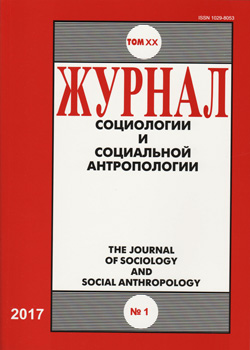The Second Youth of the Older Generation: 2016 Conferences and Forums Dedicated to the Elderly
Abstract
This is a review of several international and regional Conferences and Forums dedicated to the elderly that were organized in Saint Petersburg, Yakutsk, Arkhangelsk, Nizhniy Novgorod, and Moscow in 2016.
References
Bell. D. (2001) An Introduction to Cybercultures. London: Routledge.
Bell D. (2007) Cyberculture Theorists: Manuel Castells and Donna Haraway. UK: Routledge Taylor and Francis Group.
Beneito-Montagut R. (2011) Ethnography goes online: towards a user-centred methodology to research interpersonal communication on the internet. Qualitative Research, 11: 716–735.
Boellstorff Т. (2008) Coming of Age in Second Life: An Anthropologist Explores the Virtually Human. Princeton University Press.
Boellstorff T., Nard B., Pearce C., Taylor T.L. (2012) Ethnography and Virtual Worlds: A Handbook of Method. Princeton NJ: Princeton University Press.
Fernback J. (2007) Beyond the diluted community concept: a symbolic interactionist perspective on online social relations. New Media & Society, 9 (1): 49–69.
Haythornwaite C. (2002) Strong, Weak and Latent Ties and the Impact of New Media. The Information Society, 18(5): 385 –401.
Hine C. (2000) Virtual Ethnography. London: SAGE.
Hine C. (2015) Ethnography for the Internet: Embedded, Embodied and Every Day. Bloomsbury Academic.
Kozinets R. (2002) The Field behind the Screen: Using Netnography for Marketing Research in Online Communities. Journal of Marketing Research, 39(1): 61–72.
Turkle S. (1995) Life on the screen: Identity in the age of the Internet. NY: Simon and Schuster.
Wellman B. (1997) An Electronic Group is Virtually a Social Network. In: Culture of the internet, S. Kiesler (ed.) Hillsdale, NJ: Lawrence Erlbaum Associates: 179–205.
Bell D. (2007) Cyberculture Theorists: Manuel Castells and Donna Haraway. UK: Routledge Taylor and Francis Group.
Bell. D. (2001) An Introduction to Cybercultures. London: Routledge.
Beneito-Montagut R. (2011) Ethnography goes online: towards a user-centred methodology to research interpersonal communication on the internet. Qualitative Research, 11: 716–735.
Boellstorff T., Nard B., Pearce C., Taylor T.L. (2012) Ethnography and Virtual Worlds: A Handbook of Method. Princeton NJ: Princeton University Press.
Boellstorff Т. (2008) Coming of Age in Second Life: An Anthropologist Explores the Virtually Human. Princeton University Press.
Fernback J. (2007) Beyond the diluted community concept: a symbolic interactionist perspective on online social relations. New Media & Society, 9 (1): 49–69.
Haythornwaite C. (2002) Strong, Weak and Latent Ties and the Impact of New Media. The Information Society, 18(5): 385 –401.
Hine C. (2000) Virtual Ethnography. London: SAGE.
Hine C. (2015) Ethnography for the Internet: Embedded, Embodied and Every Day. Bloomsbury Academic.
Kozinets R. (2002) The Field behind the Screen: Using Netnography for Marketing Research in Online Communities. Journal of Marketing Research, 39(1): 61–72.
Turkle S. (1995) Life on the screen: Identity in the age of the Internet. NY: Simon and Schuster.
Wellman B. (1997) An Electronic Group is Virtually a Social Network. In: Culture of the internet, S. Kiesler (ed.) Hillsdale, NJ: Lawrence Erlbaum Associates: 179–205.

